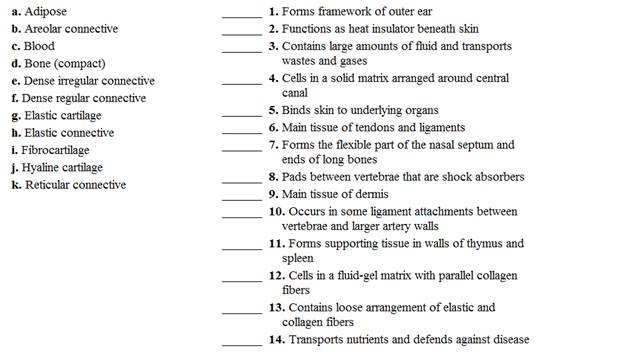
Concept explainers
Match the tissues in column A with the characteristics in column B. Place the letter of your choice in the space provided. (Some answers may be used more than once.) 
To match:
The term from column A to the correct description in column B.
Introduction:
The connective tissue is a type of animal tissue. It has a mesoderm origin. The connective tissue plays an important role in insulation, protection, support and movement of substances. The major connective tissues are lymph, bone, cartilage, and blood.
Answer to Problem 2.1A
The table below represent the correct match from the Column A to Column B.
| Column A | Column B |
| a. Adipose | 2. Functions as a heat insulator beneath the skin. |
| b. Areolar connective | 5. Binds the skin to underlying organs |
| c. Blood | 3. Contains a large amount of fluid and transport wastes and gases |
| d. Bone (compact) | 4. Cells in a solid matrix arranged around the central canal |
| e. Dense irregular connective | 9. Main tissue of dermis |
| f. Dense regular connective | 6. Main tissue of tendons and ligaments |
| g. Elastic cartilage | 1.Forms framework of the outer ear |
| h. Elastic connective | 10. Occurs in some ligament attachments between vertebrae and larger artery walls |
| i. Fibrocartilage | 8. Pads between vertebrae that are shock absorbers |
| j. Hyaline cartilage | 7. Forms flexible part of nasal septum and ends of long bones. |
| k. Reticular cartilage | 11. Forms supporting tissue in walls of thymus and spleen |
Explanation of Solution
- The adipose tissue consists of fat-storing cells called adipocytes. These cells conserve energy as fat. The adipose tissue cushions and provide the heat (insulation) to the body. Hence, this can be correctly matched with 2.
- The areolar tissue is named because of its airy appearance. It connects skin to underlying tissues. Hence, it can be correctly matched with 5.
- Blood is a fluid connective tissue. It consists of plasma and transport gases and wastes. Hence, it can be correctly matched with 3.
- Bone is a kind of dense connective tissue. The solid matrix is responsible for the rigidity of bone. The cells present in solid matrix arranged themselves around the central canal. Hence, it can be correctly matched with 4.
- The dense irregular connective tissue is the main tissue of the dermis. The underlying layer of the epidermis is called dermis. Hence, it can be correctly matched with 9.
- The dense regular connective tissue consists of parallelly arranged collagen fibers. It consists of type I collagen fiber. This tissue is mainly present in tendons and ligaments and provides high tensile strength. Hence, it can be correctly matched with 6.
- The elastic cartilage is highly flexible connective tissue. It is present in the pinnae (outer ear). Hence, it can be correctly matched with 1.
- The elastic connective tissue is a modification of dense connective tissue. It is made up of elastic fibers. The ligament attachment between the artery wall and vertebrae consists of elastic connective tissue. Hence, it can be correctly matched with 10.
- The fibrocartilage is the strongest tissue that is present in the intervertebral. The fibrocartilage works as a shock absorber. Hence, it can be correctly matched with 8.
- Hyaline cartilage is present at joint surfaces. It is commonly present in the nose, trachea, ends of long bones and ribs. Hence, it can be correctly matched with 7.
- Reticular tissue consists of reticular fibers. It acts as a supporting tissue around the lymph nodes, spleen and kidneys. Hence, it can be correctly matched with 11.
Want to see more full solutions like this?
Chapter 9 Solutions
Laboratory Manual for Holes Human Anatomy & Physiology Fetal Pig Version
Additional Science Textbook Solutions
Biology: Life on Earth with Physiology (11th Edition)
Organic Chemistry
Applications and Investigations in Earth Science (9th Edition)
Genetics: From Genes to Genomes
Campbell Essential Biology (7th Edition)
- Q8. A researcher wants to study the effectiveness of a pill intended to reduce stomach heartburn in pregnant women. The researcher chooses randomly 400 women to participate in this experiment for 9 months of their pregnancy period. They all need to have the same diet. The researcher designs two groups of 200 participants: One group take the real medication intended to reduce heartburn, while the other group take placebo medication. In this study what are: Independent variable: Dependent variable: Control variable: Experimental group: " Control group: If the participants do not know who is consuming the real pills and who is consuming the sugar pills. This study is It happens that 40% of the participants do not find the treatment helpful and drop out after 6 months. The researcher throws out the data from subjects that drop out. What type of bias is there in this study? If the company who makes the medication funds this research, what type of bias might exist in this research work?arrow_forwardHow do I determine the inhertiance pattern from the pedigree diagram?arrow_forwardits an open book assignemntarrow_forward
- Describe two different gene regulation mechanisms involving methylationarrow_forwardWhat is behavioral adaptarrow_forward22. Which of the following mutant proteins is expected to have a dominant negative effect when over- expressed in normal cells? a. mutant PI3-kinase that lacks the SH2 domain but retains the kinase function b. mutant Grb2 protein that cannot bind to RTK c. mutant RTK that lacks the extracellular domain d. mutant PDK that has the PH domain but lost the kinase function e. all of the abovearrow_forward
 Medical Terminology for Health Professions, Spira...Health & NutritionISBN:9781305634350Author:Ann Ehrlich, Carol L. Schroeder, Laura Ehrlich, Katrina A. SchroederPublisher:Cengage Learning
Medical Terminology for Health Professions, Spira...Health & NutritionISBN:9781305634350Author:Ann Ehrlich, Carol L. Schroeder, Laura Ehrlich, Katrina A. SchroederPublisher:Cengage Learning Comprehensive Medical Assisting: Administrative a...NursingISBN:9781305964792Author:Wilburta Q. Lindh, Carol D. Tamparo, Barbara M. Dahl, Julie Morris, Cindy CorreaPublisher:Cengage Learning
Comprehensive Medical Assisting: Administrative a...NursingISBN:9781305964792Author:Wilburta Q. Lindh, Carol D. Tamparo, Barbara M. Dahl, Julie Morris, Cindy CorreaPublisher:Cengage Learning





